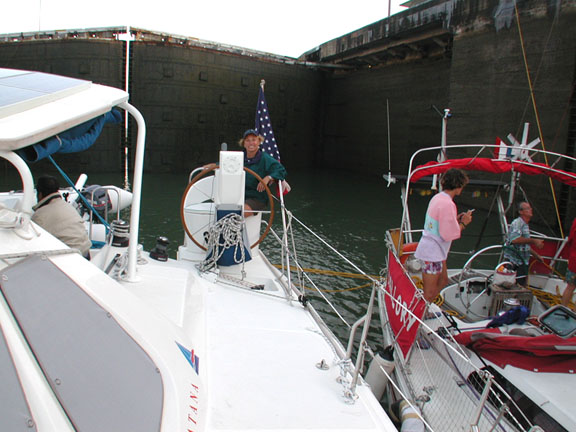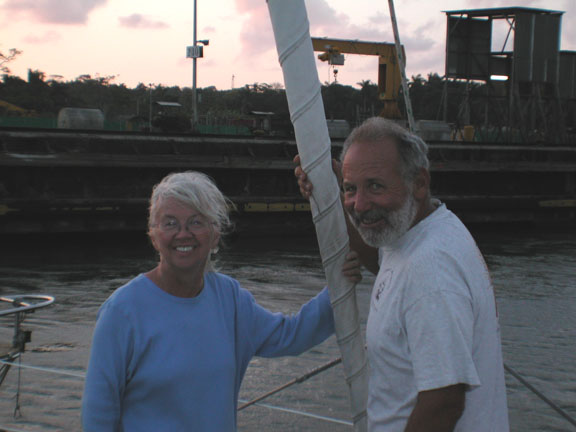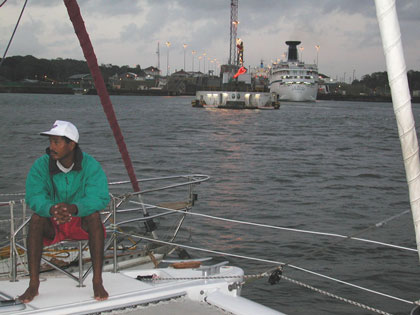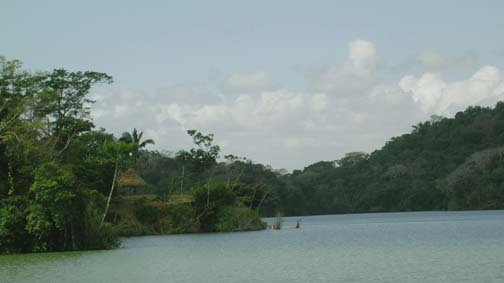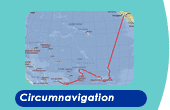Stories in this section... Colombia Pacific Bliss Transits “the
Big Ditch” Gatun Locks.The Gatun locks consist of six chambers, two lanes (east and west) of three locks in a series. Entering the locks in an awesome experience! We marveled at the engineering feat that put these locks in place. When the Gatun locks were constructed, the workers poured 3,000 cubic yards of concrete every day for 2 ½ years! After we entered, the monkey fists (a piece of lead wrapped into lines) were thrown to the two outside boats, then the lines secured to their cleats. Line handlers on the dock wall walked the boats forward, as we motored slowly. Once in place behind the cruise ship, the lines were secured to huge 18” diameter bollards lining the canal wall. The gates closed behind us, and the water filled the locks. The surface boils as water is forced through a hundred holes in the lock floor within 15 minutes. As the water rose, the slack in the lines was taken up by the linehandlers, until as we reached the top, the lines were slipped off the bollards, freeing the nested boats from the canal walls.
We remained nested until we exited the third chamber. We had been lifted 85 feet! We gasped in amazement as the lock doors opened to the wide vista ahead—fresh water! Dramatic, deep blue, Lake Gatun! We would sail on the largest man made lake in the world (at the time it was created). We motored out of the locks and untied the bow, stern and spring lines. Pacific Bliss was free again. We hoisted the main and unfurled the jib. It was only 8:10 AM and Pacific Bliss was in her element, under full sail, making between 8 and 10 knots. The PCC wants vessels to make the fastest possible time through the lake. We had convinced our pilot that our fastest time was under full sail, without the engines. The two monohulls headed for the Banana Cut, a narrow shortcut between lush islets, to save time, under sail plus engine. Our pilot wanted us to stay in the main channel through the lake, which we would follow for 20.5 miles. It was a beautiful sail. We sailed past the Barro Colorado National Monument, an island operated by the Smithsonian Tropical Research Institute, considered to be a tropical moist forest. It contains more than 60 troops of Howler monkeys, 366 species of birds, 30 species of frogs, 22 species of lizards, and 40 species of snakes. The 15 sq. km island contains a complete biological station with laboratories, libraries and living accommodations for scientists. Right after the island, as we passed buoys 35&37, we met the monohulls that left us at buoys 5&7. Despite their shortcut and motor running, Pacific Bliss, having completed the Pena Blanca Reach, was right behind them.
From there, I took the helm for the first time during our transit, and enjoyed the fun and challenge of attempting to pass the mono hulls under sail, rounding the buoys of Bordada Bohio, Bordada Buena Vista, Tabernilla Reach, and San Pablo Reach. I passed one yacht, then we all lost our wind. At 10:20, according to the ship’s log, we took down the sails and motored, wind at only 14 knots, right on our nose. Soon the village of Gamboa was ahead on our port and we were on Gamboa Reach. Many sailing vessels have to spend the night anchored in Gamboa Reach, especially those who (1) cannot maintain an eight-knot speed, (2) leave later in the day, or (3) do not have a licensed pilot on board. Gaillard Cut. Having passed Gamboa, we entered a nine-mile long cut carved through rock and shale called the Gaillard Cut. This cut had been one of the most difficult challenges in building the canal. There were repeated landslides. Contractor’s Hill, on the west bank of the canal, was sliced from 410 feet to 370 feet to stabilize the earth, but landslides still occur; the most recent was in 1987. The canal section north of the area was widened from 300 feet to the present 500 feet to allow large ships to pass each other there. As the ships grow larger, another widening is in process. Dredging vessels were running back and forth as we passed. Earth moving equipment lined the banks. Gunter and I have been reading David McCullough’s comprehensive book, The Path Between the Seas. He describes the Culebra (now called Gaillard, after U.S. Major Gaillard) Cut as the “special wonder” of the canal. The building of the Gatun Dam or the construction of the locks, projects of colossal scale and expense, were always of secondary importance, he said, as long as the battle raged in the nine-mile stretch between Bas Obispo and Pedro Miguel. The struggle lasted seven years, from 1907 through 1913, when the rest of world was at peace. In the dry season (which we are in now) the tourists came by the hundreds, and later by the thousands, to stand and watch from grassy vantage points hundreds of feet above it all. Special trains were arranged to bring them in, and special tours were sold. The men wore white shoes and pale straw hats, the ladies ankle-length skirts, carrying parasols for protection against the tropical sun. Lord Bryce of the time called the spectacle the “greatest liberty ever taken with nature.” Just putting into word pictures the volume of earth that had to be removed was hopeless. The journalists of that time tried to broadcast the statistics: 15,700,000 cubic yards in 1907, and incredible 37,000,000 in 1908. The figures were beyond comprehension. Just how much was that? The spoil from the canal prism, it was said, would be enough to build a Great Wall of China from San Francisco to New York. If the United States were flat, the amount of digging required for a canal ten feet deep by fifty-five feet wide from coast to coast would be no greater than what was required at Panama within fifty miles. A train of dirt cars carrying the total excavation at Panama would circle the world four times at the equator. The spoil would be enough to build sixty-three pyramids the size of Cheops. Scientific American commissioned an artist to draw Manhattan with giant pyramids lining the length of Broadway from Battery to Harlem! If all the material from the canal, another journalist explained, were placed in a solid shaft with the base the dimension of a city block, it would tower nearly 100,000 feet—nineteen miles—in the air. All these word pictures are one thing. But then there’s the rest of the story. The fact that that all this was begun in the early 1900s, without the benefit of the modern earth moving equipment and project management tools we now have at our disposable, makes the story even more incredible. Imagine the smothering heat of Panama at 9 degrees latitude (our crew went through 7 gallons of water that day, in addition to the Coke the Panamanians crave), the rains, the mud, the insects, and the diseases! At the bottom of the Cut at midday the temperature was seldom less than 100 degrees, more often it was 120 to 130 degrees. Yet when the work under Goethals was at its height, the United States was excavating at Panama the equivalent of the Suez Canal every three years! In fact, the 37,000,000 cubic yards of earth and rock removed in the one year of 1908 was nearly half as much as two successive French companies had succeeded in digging at Panama in a total of seventeen years. |
|
journal28page2.html |
|
|
